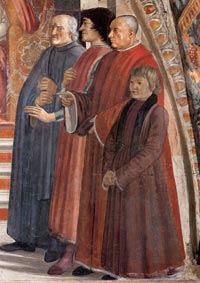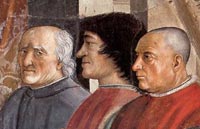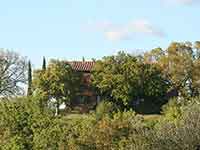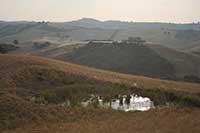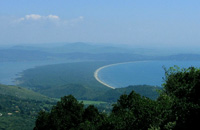 |
|||
Sandro Botticelli, Adoration of the Magi, c. 1475-1476, tempera on panel, Uffizi, Florence |
|||
| Sandro Botticelli | Adoration of the Magi, 1475-1476 |
| The Adoration of the Magi motif was unusual for Florentine altar scenes until the 15th century. One of the first presentations of the Adoration of the magi is found on the Strozzi altar of Gentile da Fabiano, dating in 1423. But the 15th century was its golden age, probably due to many brotherhoods in Florence. One of the most important congregations was so-called Brotherhood of the Magi, (Compania dei Magi, also called Confraternity of the Star). Their selected members also included the Medici family. Compagnia dei Magi organized magnificent processions in Florence, from the monastery of St Marco to the Baptistery, which were performed every five years on Epiphany, the feast day of the Magi. Lorenzo il Magnifico, the grand son of Cosimo il Vecchio was even baptized on January the 6th, the feast day of the Magi. Members of the important families in Florence were often portrayed as magi or as their companions on the paintings with the motif of the Adoration of the Magi. There are several representations of this motif which depicted portraits of Medici. They were made by the most known Italian renaissance artists such as Gozzoli, Botticelli, Veneziano, Lippi, Ghirlandaio… At the height of his fame, the Florentine painter and draughtsman Sandro Botticelli was one of the most esteemed artists in Italy. Sandro Botticelli, (1445-1510) was the son of Mariano di Vanni Filipepi, Alessandro — whose nickname derives from that of his brother Giovanni, called "Botticello" (little barrel). Botticelli entered Filippo Lippi's workshop toward the end of the 1450s. The mark of Lippi's style is clearly recognizable in Sandro's earliest paintings, works such as the Madonna and Child in the Ospedale degli Innocenti in Florence and the Madonna and Child with an Angel in the Musée Fesch in Ajaccio. In 1472, Botticelli joined the Compagnia di San Luca, the confraternity of Florentine painters. He also employed Filippino Lippi, his late teacher's son, as his apprentice, and broke convention by completing Filippino's version of The Adoration of the Kings — it was far more usual for an apprentice to finish a painting by his master rather than the other way round.[2] Botticelli's apprenticeship with Fra Filippo gave him excellent contacts. His master had enjoyed the patronage of some of the leading families in Florence, such as the Medici. Botticelli in turn spent almost all his life working for the Medici family and their circle of friends, for whom he painted some of his most ambitious secular paintings such as Primavera (in the Uffizi, Florence). In the Uffizi there is another painting by Sandro Botticelli which is both a portrait of the Medici family and a self-portrait of the artist. It is the celebrated Adoration of tlre Magi , painted around the year 1475 for the chapel patronized by the Lama (or Lami) family in Santa Maria Novella. It is the picture that, according to Vasari, made the young Sandro famous in Florence and Italy and opened the way to Rome. The painting is based on a subtle web of symbolic references. The Lami Chapel was dedicated to the Epiphany because the client's name, Gaspare, was the same as the one traditionally attributed to one of the three Magi. This explains the choice of the iconographic subject. But the journey of the Magi to the stabIe in Bethlehem had already become part of Medici mythography. Less than twenty years earlier (1459) Benozzo Gozzoli had painted a fresco in the private chapel of the family palace, the celebrated ceremonial and formal cavalcade known as the Journey of the Magi in which we can recognize, alongside eminent figures of the Italian aristocracy (Pandolfo Malatesta, Galeazzo Maria Sforza) and the most prominent notables of the city oligarchy, several members of the Medici house: Cosimo the head of the family, his son and heir Piero, probably his illegitimate son Giovanni and the children Lorenzo and Giuliano. [4] |
|
|||
In the painting formerly in Santa Maria Novella the appropriation of the myth by the Medici has become total, in the sense that the Medici have become the Magi. In fact we can identify, with certainty, the aged Cosimo kneeling in an act of devotion at the feet of the Virgin, bis eldest son Piero in a red cloak seen from behind at the centre of the composition, and on his right the other son Giovanni, dressed in white and also on his knees. |
|
|||
|
|
|
||
 |
||||
Sandro Botticelli, Adoration of the Magi, c. 1475-1476, tempera on panel, Uffizi, Florence |
||||
| The only thing we can be sure of is that the protagonists of the sacred representation, i.e. the three Magi, are Cosimo, Piero and Giovanni de' Medici in the order and the attitudes in which I have described them. The three members of the family portrayed in the guise of the Magi were all dead at the time Botticelli painted the Adoration of the Magi now in the Uffizi. So their presence has the significance of a sort of sanctification post mortem. In another age and a different city, presenting three contemporaries who had passed away not many years previously as saints (the Magi were and still are considered such to all intents and purposes) would have created some embarrassment and prompted more than legitimate prohibitions. All the more so given that this sanctification in effigy was done on the altar of a public chapel, in one of the most famous. and venerated churches in Christendom. A church (it should not be forgotten) governed by the Dominicans, the order that was the learned custodian and unbending guarantor of theological and liturgical orthodoxy and of canonical correctness. But what would have appeared reckless at the very least elsewhere in Italy and Europe was evidently quite feasible in the Medicean Florence of the late fifteenth century. A family of wealthy private citizens which had established its dominance while maintaining a formal respect for republican institutions, it exercised de facto such power as to render possible blatantly and sickeningly adulatory public tributes like the one paid by Gaspare Lami in the chapel of the Epiphany in Santa Maria Novella. In the age of Lorenzo the Magnificent the hegemony of the Medici family over the State was achieved with the support of the bourgeois oligarchy and relied on such celebratory propaganda. To do so, it made extensive, decisive and canny use of the figurative arts. In certain cases the two instruments of consensus (political support of the elite, public celebration through painting) were used side by side and can be found in the same work. The perfect example of this aspect of late fifteenth-century Medicean Florence was to be realized, about ten years after the execution of the altarpiece of the Epiphany, in Domenico Ghirlandaio's frescoes in the Sassetti Chapel in Santa Trinita. Francesco Sassetti was a major figure in the Florentine financial oligarchy and decided to decorate his family chapel with a cycle of frescoes devoted to the life and miracles of his patron saint, Francis of Assisi. Yet it is clear straightaway that in the cycle in the Sassetti Chapel the presence of the Poor Man of Assisi is little more than a pretext. He plays the part of a modest second lead. The main character is Lorenzo the Magnificent, represented alongside Sassetti himself, his children and their famous tutors (Politian, Luigi PuIci, Matteo Franco) in the scene of the Confirmation of the Rule. A Ieading role is played by Florentia felix at the height of Medici power, and in fact the pope and the college of cardinals who receive St. Francis for the approval of the Rule have been transferred from the Lateran to Piazza della Signoria, between Palazzo Vecchio and Orcagna's Loggia. Another leading role is taken by the wealthy bourgeois elite, the Pucci, Acciaioli, Strozzi and Antinori who-politically guided and represented by Lorenzo the Magnificent-are present at the miracle of the boy of Casa Spini. I believe these to have been the paintings that really scandalized Girolamo SavonaroIa: works, I mean, such as the altarpiece of the Epiphany commissioned from Botticelli by Gaspare Lami or Domenico Ghirlandaio's frescoes in the Sassetti Chapel. In the friar's eyes — in other words Iooked at from his viewpoint as a moralistic theologian — these paintings in which the Church of Christ was reduced to an instrumentum Regni must have appeared more offensive than the lascivious profane fables which decorated the headboards and wedding chests of bourgeois houses in Florence, or the mythologies which, in those very years, Botticelli was producing for the Medici clan, "With Venus and the Primavera as emblems of the new paganism. But this is a question that would take us a long way off our subject.[5] |
|
|||
 |
||||
Sandro Botticelli, 1446 - 1510, The Adoration of the Magi, c. 1478/1482, tempera and oil on panel,
|
||||
Galleria degli Uffizi
All of Florence’s state-run museums belong to an association called Firenze Musei,
|
S E C O N D F L O O R
|
|||
|
||
[3] The client, Gaspare di Zanobi della Lama (we can see him in the second row on the right, standing slightly back with the air of a host who does not wish to appear too pushy to his guests), was a man who had made his fortune as an intermediary in the banking and financial sector. Of humble origin he was the son of a barber from Empoli), he had become so wealthy that he could afford a chapel in Santa Maria Novella and had risen so high on the social scale that the homage he paid to the Medici, his colleagues in the banking world, must not have seemed improper or out of place in the Florence of 1475. One of the most important congregations was so-called Brotherhood of the Magi, (Compania dei Magi, also called Confraternity of the Star). Their selected members also included the Medici family. Compagnia dei Magi organized magnificent processions in Florence, from the monastery of St Marco to the Baptistery, which were performed every five years on Epiphany, the feast day of the Magi. Lorenzo il Magnifico, the grand son of Cosimo il Vecchio was even baptized on January the 6th, the feast day of the Magi. See also Benozzo Gozzoli, Procession of the Magi in the Palazzo Medici-Riccardi in Florence [5] Antonio Paoluccii, Botticelli and the Medici: a privileged relationship, in Botticelli : from Lorenzo the Magnificent to Savonarola, Milan: Skira ; London: Thames & Hudson, 2003.
|
 Probable portrait of Gaspare di Zanobi della Lama, in his Adoration of the Magi, Uffizi, Florence Probable portrait of Gaspare di Zanobi della Lama, in his Adoration of the Magi, Uffizi, Florence |
|
| Daniel Arasse and Pierluigi De Vecchi, Botticelli : from Lorenzo the Magnificent to Savonarola, Milan: Skira ; London: Thames & Hudson, 2003. [Content | Botticelli's manner / Daniel Arasse — Love and the figure of the nymph in Botticelli's art / Charles Dempsey — Movement, action and expression in the work of Sandro Botticelli / Pierluigi De Vecchi — The figure of Mary in Botticelli's art / Alessandra Galizzi Kroegel — Botticelli and the Medici: a privileged relationship / Antonio Paolucci — The real Botticelli / Claudio Strinati ] In 2007, Pope Benedict XVI has appointed Antonio Paolucci Director of the Vatican Museums.At 68, formerly Italian Minister of Culture from 1995 to 1996, Antonio Paolucci is a renowned art historian of the Renaissance. A student of Roberto Longhi, he started out at the Soprintendenza per i Beni Culturali for the Venice Region (1969-1980), then worked for the Mantova-Brescia-Cremona Region (1984-1986) before directing the Office of hard stones and the restoration laboratory in Florence (1986-1988), the Department of Artistic Affairs of Tuscany (1988) and then becoming director of the museums in Florence (2004-2006). He supervised the commission in charge of the restoration of the Basilica of Saint Francis of Assissi after the earthquake in 1997 and is president of the Accademia Carrara in Bergamo. Four years ago he was at the center of the controversy concerning the restoration of Michelangelo’s David in Florence. He is the author of over 300 articles in various journals such as Paragone or Bollettino d’Arte, and of monographic studies on Palmezzano, Signorelli as well as other Florentine artists or monuments. |
||
|
||
 |
||||
|
||||
 |
||||
Podere Santa Pia |
Podere Santa Pia, view from the garden on the valley below |
Century-old olive trees, between Podere Santa Pia and Cinigiano |
||
Tombolo di Feniglia |
Monte Argentario, view from Scansano |
Campagnatico |
||
 |
 |
|||
Sovicille |
Siena, Palazzo Publicco |
Sunsets in Tuscany |
||
 |
||||
Santa Pia is set in an extremely panoramic spot, dominating over the valleys, the countryside, up to the Tyrrhenian coast
|
||||
| This page uses material from the Wikipedia article Sandro Botticelli, published under the GNU Free Documentation License. | ||||




 Piero de' Medici
Piero de' Medici Giovanni de' Medici
Giovanni de' Medici Giuliano de' Medici
Giuliano de' Medici